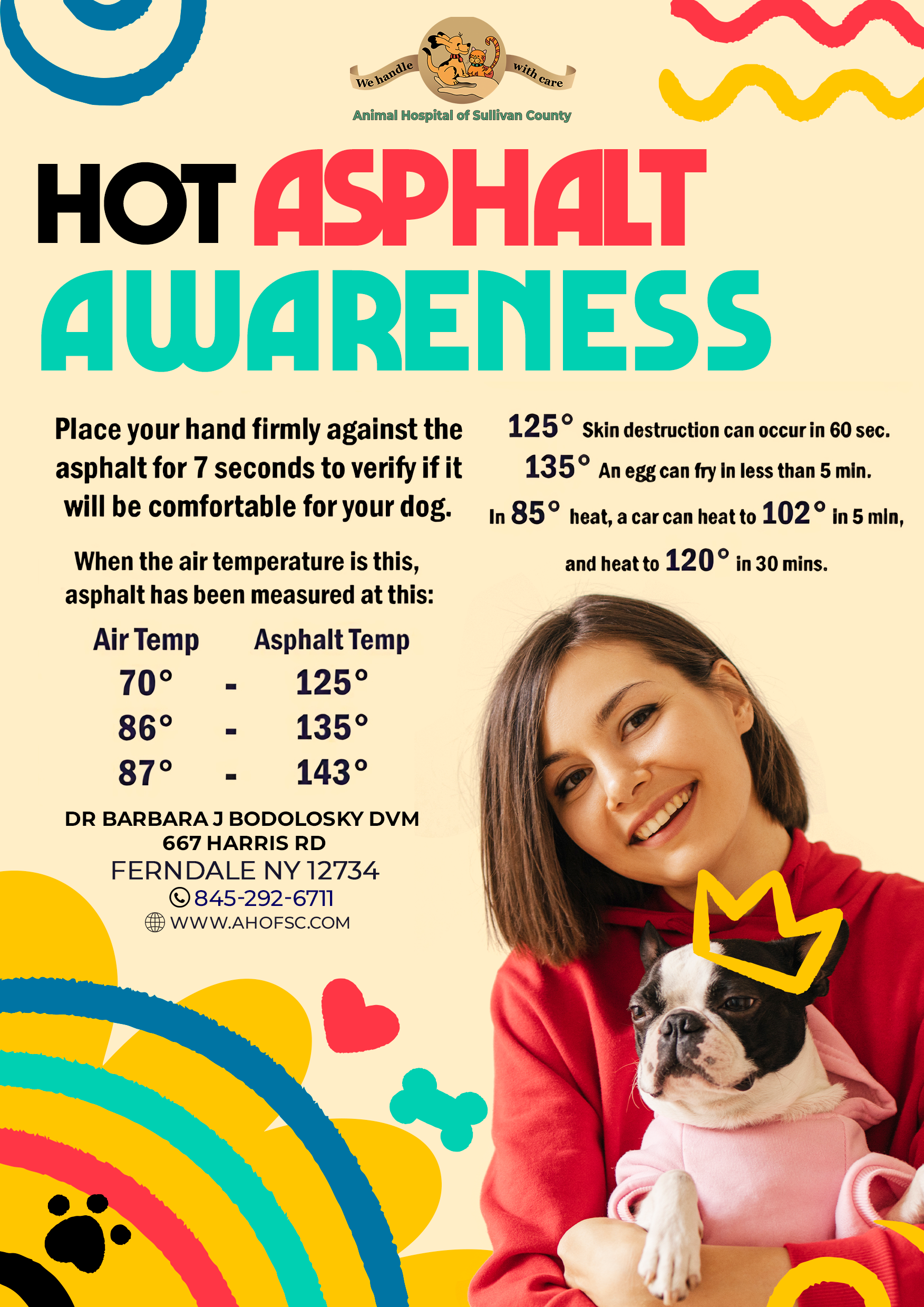
August is Hot Hot Hot
At the Animal Hospital of Sullivan County, we like to take a “ground up” approach to your pet’s care. And what better way to start than where the rubber meets the road? Or—more properly—where your pet meets the ground…
Yup, we’ll be talking over your doggie’s feet in this month’s blog. And why not? The condition of Fluffy’s paws will help determine her stability, balance, and traction as she navigates this big ol’ wide world (or your fenced-in back yard).
There are a couple of times a year to be particularly diligent about caring for Jupiter’s feet: during the freezing cold winter…and at this time of the year when things get really hot. (You might recall that I mentioned in passing a while back that hot summer surfaces—such as sidewalks and roads—might burn your animal friend’s feet.)
Let’s start with a little awareness regarding the basics: Corral’s nails and pads.
Generally speaking, it’s a good idea to get your fur-buddies used to the idea that you’ll be touching their feet from an early age. This will save a battle when the time comes for maintenance and/or treatment.
When you do, take a good look at the condition of both the nails and pads. Of course, you’ll want to keep the nails trimmed. And you’ll note that your pup’s pads are made up of fatty tissue covered with black or pink skin. Plus, they’ll be representative of Cashew’s lifestyle. If she’s mostly walking on smooth surfaces and soft grass, her pads will be smooth and supple. And if she’s tearing through rugged terrain on a regular basis? Then her pads will be calloused…much like guitar players build calluses on their fingers from fretting strings.
As we’ve seen above, one of the biggest dangers to your pet’s pads is pavement and/or asphalt that’s too hot. You can check for this by touching the back of your hand to it. If it’s too hot for you, it’s too hot for your doggie to walk on. Stay in the shade, keep the walk short, and bring along plenty of water.
Wintertime offers challenges of its own, including snow, ice, and ice melt products. We want to be particularly careful around the stuff that melts ice, because it can deadly if Poodles downs it. (Letting him lick the residue off of his feet isn’t a good idea, either, so wash and dry his paws after an outing where encountering ice melt is a possibility.)
Also be mindful that snow and ice can collect between Charity’s toes, which can refreeze, push the toes further apart, and tug on the fur there. Ouch! Is it any wonder that some folks purchase dog booties for their animal friends to help them through such cold times? Or maybe apply some paw wax? (Check with your veterinary professional for recommendations.)
At any time of the year, it’s a good idea to periodically examine your pooch’s feet. Just spread his toes a bit—be gentle, now—to look for injuries or things that don’t belong…like little sticks or stones or burrs or cysts. Watch your dog’s reaction—a flinch might indicate some sensitivity and/or pain. And be sure to keep the fur between the toes trimmed. (If Ozzy is a little squirmy, it’s okay to tackle one foot a day.)
In between doing check-ups of your own, make some time to observe how Fluffy is treating her paws herself. Something might be wrong if you observe the following:
· You see that she’s limping.
· Her paw looks red and swollen.
· She’s licking her paw a lot.
· Her nails are cracked.
· Her pads are cracked and dry.
· There’s a bad smell coming from a paw.
· You observe bleeding or a discharge.
· She’s losing some hair on a paw.
There are a variety of reasons why Fluffy’s feet might be hurting. Among them:
1. Fungal and/or bacterial infections. It’s normal for your pup to host fungi and bacteria on his paws, but sometimes the balance goes whacko. He’ll lick and chew an infected paw, and you’ll see that the skin between his toes is red. Luckily, we can provide you with a correct diagnosis and, in general, provide treatments with topical creams and washes.
2. Allergies. Yup, most everybody’s got ‘em, and sometimes, they can cause issues for your pet’s feet. Bring that poor, itchy pooch to us, and we’ll get to the bottom of what’s bothering her and set her up with the right treatment for relief.
3. Overgrown toenails. Sure, Ozzy is twitchy and that makes trimming his nails back an adventure for everyone. But overgrown nails create unnatural pressure on the nail bed, which causes Ozzy pain. Nails that are too long are at increased risk for becoming torn…and that can really hurt. If you need help clipping the claws, give us a ring and come right in! (See what I did there?)
4. Ingrown nails can be an issue as well, and increase the risk of infection. We know how to gently get those pesky hide-and-seekers taken care of.
5. Dry, cracked paws. These can be caused by dry air, chemicals, rugged terrain, and—yes—hot pavement. Luckily, these can be effectively treated with paw balms, lotions, or wipes. Check with your veterinary professional for sure.
As always, a little preventative intervention can help keep our animal friends happy, healthy, and—yes—on their feet. So, check those paws and help your doggie romp through his best life!
Reminder: Are you up to date on your pet’s rabies shot? I’m sure you know that rabies is no joke, plus New York State law requires that your furry companion be vaccinated. There are various shots that can be utilized; some offer protection for a year, others for up to three…but none of them are permanent. At the Animal Hospital of Sullivan County, we always remind our clients when their pets are due for their shots. But if you’re not sure, you can always give us a call: 1-(845) 292-6711.
Have a safe and happy August!


